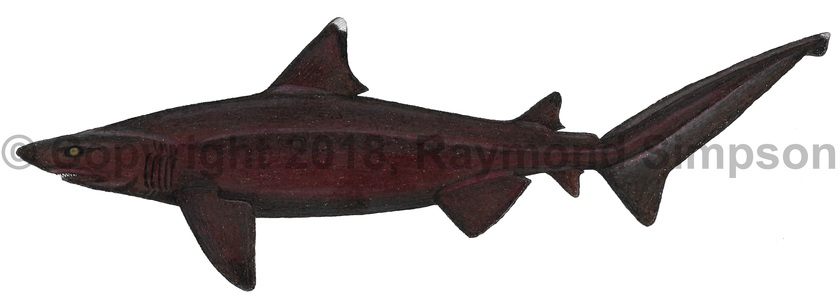
Common Name
Bigeye Sand Tiger
Year Described
Maul, 1955
Identification
Teeth rows: 34-43 upper, 37-46 lower
Body heavy and robust. Head and snout relatively deep with a large mouth with prominent teeth easily visible when mouth is closed. Snout relatively long but flattened. Teeth long and thin with single prominent lateral cusplets. Post-oral grooves absent. Eye large. Gill slits large with last two slightly closer together at pectoral origin. First dorsal fin placed well back on body (slightly behind rear tip of pectoral fin) and triangular. Second dorsal fin less than half the size of D1. Pelvic and anal fins also placed far back on body, with anal fin being much smaller than pelvic fin and second dorsal fin. Pelvic fin as large as D1 and closer to D2 than D1. Anal fin origin under rear of D2. Pectoral fin large with a squared off edge. Caudal fin with a strong upper and a weak lower lobe. Subterminal notch strong but terminal lobe small. Precaudal pit only present dorsally. No lateral or peduncular keels. Skin rough.
Color
Body entirely dark red-brown with no markings. Tip of dorsal fin sometimes white. Eye greenish.
Size
Maximum size to over 400cm TL. Matures adults from 320cm TL with females averaging slightly larger. Newborn size unknown.
Habitat
Midwater oceanic or over bottom in deep water (35-100m but more common deeper).
Range
Known from off Florida, the Gulf of Mexico, and off northeastern Brazil (original description). Rarely encountered but probably more widespread in deep midwater habitats.
References
Castro, J.I. 2011. The Sharks of North America. Oxford University Press, 640 pp.
Ebert, D. A., & M. Dando. 2020. Field Guide to Sharks, Rays & Chimaeras of Europe and the Mediterranean. Princeton University Press. 2020.